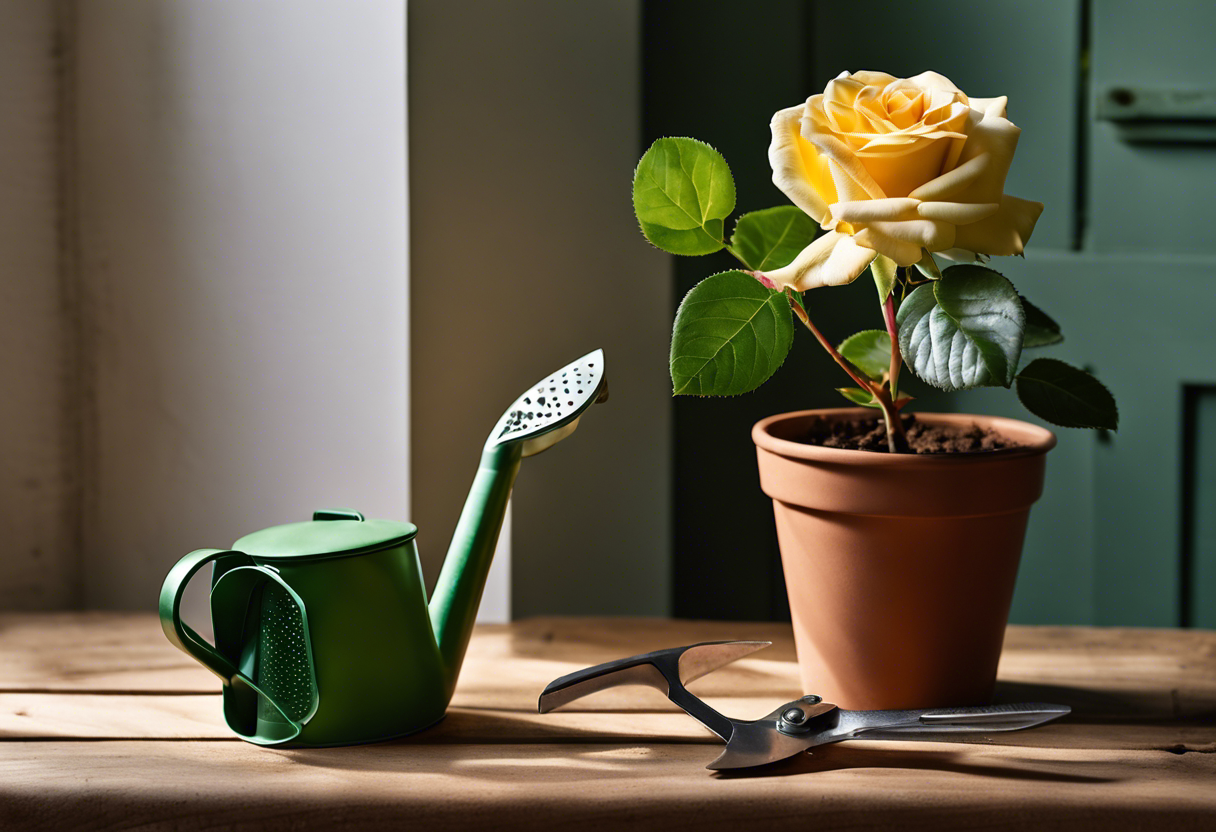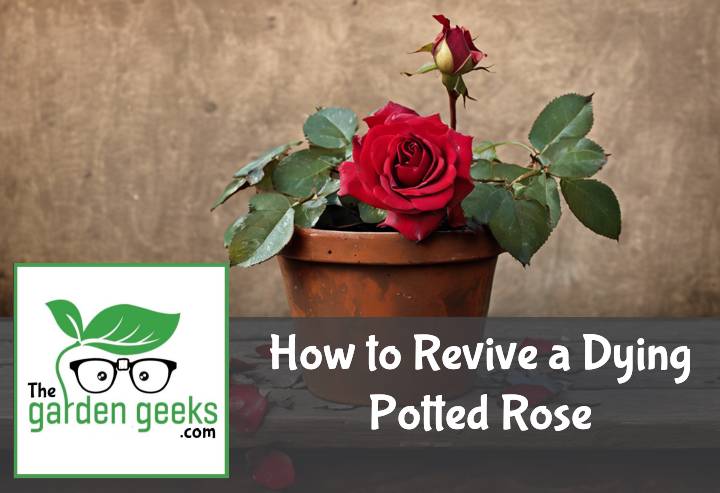Ever found yourself staring at a wilting rose, feeling as helpless as a bee without nectar? Well, I have. And let me tell you, it’s no bed of roses! But don’t fret. With a little know-how and some TLC, you can learn How to Revive a Dying Potted Rose.
In this journey of botanical resuscitation, we’ll identify the signs of a dying rose, understand the role of proper care, assess soil conditions, prune like pros and even consider repotting if all else fails. So buckle up buttercup… or should I say rosebud? Let’s bring that potted beauty back to life!
Key Takeaways
- Identify signs of a dying rose like wilting, yellow leaves, and lack of growth.
- Overwatering or underwatering can cause these symptoms. Adjust watering based on the plant’s needs.
- Ensure the rose is getting enough sunlight, ideally 6 hours daily.
- Check for pests or diseases and treat accordingly with organic pesticides or fungicides.
- Repot the rose if it’s outgrown its pot or the soil has become depleted. Use fresh, nutrient-rich soil.

Understanding the Signs of a Dying Potted Rose
When it comes to how to revive a dying potted rose, the first step is recognizing that your rose is in trouble. You need to become a plant detective, looking for clues and signs of an unhealthy rose.
Identifying Common Symptoms of a Dying Rose
One telltale sign is wilted leaves. If your rose’s leaves are drooping like they’ve just heard some really bad news, it might be on its way out. Another symptom is yellowing leaves. It’s like the plant version of jaundice – not good at all!
Now, if you see brown spots on roses or lack of blooming, these could also be red flags. Your rose might be screaming for help in its own silent, planty way.
Recognizing Disease and Pest Infestations
Disease in roses can often show up as something called black spot disease. If your rose looks like it’s been playing in soot, you’ve got a problem. Then there are aphids on roses – tiny little bugs that suck the life out of your plants.
Powdery mildew on roses is another common issue – it looks like someone dusted your plant with flour. And let’s not forget about Japanese beetles on roses – they’re the bullies of the bug world and love munching on your poor roses.
Finally, there’s rose rust fungus which gives your plant an unattractive orange hue. So keep an eye out for these signs and act swiftly to save your potted beauty!
The Role of Proper Care in Reviving Your Rose

When it comes to reviving dying roses, proper care is the secret sauce. It’s like a lifeline thrown to a drowning man. We’re talking about potted rose care that focuses on watering techniques and understanding the impact of sunlight and temperature.
Importance of Correct Watering Techniques
Now, let’s talk water. You know, H2O, that life-giving liquid? Well, it turns out correct watering for roses can make or break your revival mission. Overwatering is like drowning your rose in kindness – too much love can kill you know! And underwatering? That’s just plain neglect.
But don’t fret! Understanding your rose’s hydration needs and establishing a solid watering schedule for roses can turn things around. It’s all about balance, my friend. Not too much, not too little – just right!
The Impact of Sunlight and Temperature
Moving on to our next big players: sunlight and temperature. These two are like the dynamic duo of potted rose care. Too little sunlight makes your rose feel neglected while too much might just give it a nasty sunburn!
Understanding the sunlight needs for roses is crucial in this journey of revival. And what about temperature? Well, each rose has its own comfort zone when it comes to temperature tolerance.
The key here is creating optimal growing conditions for your potted beauty. Remember, we’re trying to figure out how to revive a dying potted rose, not how to create a sauna or freezer for them! So keep an eye on those indoor temperatures and ensure they’re getting their daily dose of sunshine!

Assessing and Improving the Soil Condition
When it comes to how to revive a dying potted rose, you can’t overlook the importance of soil condition. It’s like the bedrock of your rose’s health, with pH levels and nutrient content playing starring roles.
Checking Soil pH Levels
So, let’s talk about soil pH levels. These little numbers can make or break your rose’s mood. You see, roses are picky eaters. They prefer their soil slightly acidic to neutral. That’s around 6.0 to 7.0 on the pH scale for those keeping score at home.
Now, how do you check this? Well, you’ll need a soil testing kit from your local garden center or online store. It’s as easy as pie! Just follow the instructions on the package, and voila! You’ve got your soil’s pH level.
But what if your soil is more alkaline or acidic than a rose plant prefers? No worries! To increase acidity, try adding some organic matter like peat moss or composted leaves. On the other hand, if it’s too acidic, a bit of lime should do the trick!
Enhancing Soil Nutrient Content
Moving on to nutrient content, another key player in our game plan for potted rose care. Think of it as food for your roses – they need a balanced diet just like us!
You can enhance nutrient content in two ways: organic and non-organic methods. For organic options, compost or well-rotted manure works wonders! They’re packed with nutrients that promote healthy rose growth.
Non-organic nutrients aren’t bad either! A slow-release granular fertilizer designed specifically for roses could be just what your plant needs for a nutrient boost.
Remember folks, whether you choose an organic fertilizer or go down the non-organic route, the goal is to create a rich potting mix. Your roses will thank you for it!
Pruning and Maintenance for Plant Health
Ain’t no secret that potted rose pruning is a biggie when it comes to keeping your roses in tip-top shape. It’s like a spa day for your plant, helping maintain its rose plant health. So, let’s dive into the nitty-gritty of pruning and routine care.
When and How to Prune Your Rose
You might be wondering, “When’s the best time to prune roses?” Well, late winter or early spring is usually your best bet. That’s when they’re still dormant but just about ready to burst into action.
Now, onto the how-to. Start by snipping off any dead or diseased branches – they’re just dragging your rose down. Then, trim back overgrown shoots to keep things neat and tidy. Remember, it’s all about balance here!
The trick is using sharp secateurs and making clean cuts at a 45-degree angle above an outward-facing bud. This encourages growth outwards rather than inwards – think open and airy! And voila! You’ve mastered the art of pruning potted roses.
Regular Maintenance Practices
Alrighty then, let’s talk regular maintenance for our leafy friends. Watering? Check! Soil checks? Check! Pest control? Double check!
Watering is key but remember not to drown ’em – once or twice a week should do the trick depending on weather conditions. Too much water can lead to root rot which is a total buzzkill for your rose.
Next up: soil checks! Make sure you’ve got well-draining soil that’s rich in organic matter (think compost or aged manure). Roses love this stuff!
And lastly, pest control. Keep an eye out for pesky bugs or diseases that could harm your rose. If you spot anything suspicious, nip it in the bud (pun intended) with an appropriate treatment.
So there you have it, folks! A crash course in how to revive a dying potted rose through regular maintenance and pruning. Keep these tips in mind and your roses will be blooming beautifully in no time!
Repotting: A Last Resort to Save Your Rose
Repotting is the Hail Mary of rose care, a last-ditch effort to revive a dying potted rose. It’s not something you do on a whim, but when the chips are down and your rose is struggling, it can be a game-changer.
Deciding When Repotting is Necessary
So how do you know when it’s time to pull out the big guns and repot? Well, there are some telltale signs. If your rose has stopped growing or its leaves have started yellowing despite proper care, it might be screaming for more space.
Repotting at this stage becomes crucial in saving a dying plant. It gives the roots room to breathe and spread out. Plus, fresh soil can provide much-needed nutrients that have been depleted over time.
Steps to Safely Repot Your Dying Rose
Now let’s get down to business – how do we safely repot our roses without causing further harm? First off, choose a new pot that’s bigger than the current one. You want enough space for those roots to stretch their legs.
Next up, gently remove the rose from its current pot. Be careful here; you don’t want to damage those precious roots! Fill up your new pot with fresh soil and place your rose in there.
Finally, give your newly potted rose a good watering and place it in a sunny spot. With patience and love, this could be just what your rose needs to bounce back from near death! Remember folks, reviving roses through repotting isn’t rocket science; it just requires some tender loving care!

To Wrap Up
Just like a knight saving a damsel in distress, you’ve now got the know-how to swoop in and save your wilting rose. Remember, patience and persistence are key when learning How to Revive a Dying Potted Rose.
Don’t let those green thumbs of yours turn blue out of despair. Instead, use them to breathe new life into your potted beauty. You’ve got this!


